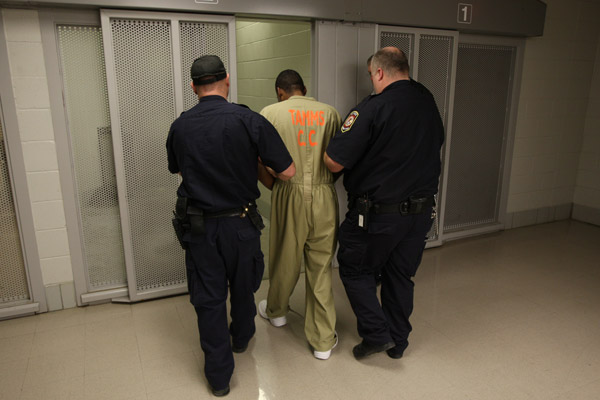
AFSCME, the union that represents prison employees at Tamms, has been basically on its own—even in a fairly pro-union state—for digging its heels in on the closing of the underused supermax. The latest shot fired at the union comes from Mother Jones (named after a labor leader), in a piece entitled "Big Labor's Lock 'Em Up" mentality:
The major force holding up Tamms' closure was the American Federation of State, County, and Municipal Employees (AFSCME), which, according to its website, represents 85,000 corrections employees nationally. The union challenged Quinn's order through its legislative allies, stalled it via the courts, and mounted a public campaign to keep Tamms open. It was perhaps the most visible and contentious example of a phenomenon seen, in one form or another, around the country: otherwise progressive labor unions furthering America's addiction to mass incarceration. In terms of prisoners rights in general, and solitary confinement in particular, unions are seen as a major obstacle to more-humane conditions.
Tamms has been a target for obvious reasons, and its closing was a remarkable victory for Tamms Year Ten. Between budget cutters on one side and human-rights activists on the other, AFSCME has been fighting an extremely unpopular battle. The Mother Jones piece describes why this is a problem for the union, but it leaves out some important context.
Tamms is located in Alexander County, and Alexander County is very poor: the poorest county in the state by most measures. Its poverty rate is 31.4 percent, twice the statewide average and just behind nearby Jackson County, the only two counties above 30 percent. Its child poverty rate is an astonishing 48 percent, more than twice the state average, and its poverty has increased substantially since 2000. Since then it's lost 14 percent of its population.
As a result, the union's only staunch defenders have been locals:
The potential loss of the prison in the 700-resident town would sting across the region. Calling the closure “a profound and staggering loss,” the five-county Southern Five Regional Planning District and Development Commission forecast that eliminating the prison’s 250 jobs ultimately would cost more than 200 indirect ones and reduce the region’s gross domestic product by $55 million.
[snip]
More than 60 Alexander County residents work at Tamms. The workforce includes 91 residents of Union County, 42 from Williamson County, 32 from Pulaski County, and others who commute from at least a half-dozen other counties, said Houston, whose wife works at Tamms as a counselor supervisor.
At Egyptian Community Unit School District, Superintendent Brad Misner said enrollment has steadily declined over the past couple of decades — from 800 students in 1994 to 525 — as jobs in the area dried up.
“If this prison is shut down, look for us to lose another 10, 15, possibly 20 percent of the students,” he said. “The support was here for the governor, and he’s kind of turned his back on us.”
Union employees have been offered jobs elsewhere in the system… but those jobs would be elsewhere, solving only half the problem.
Insofar as "big labor" has a lock 'em up mentality, it has to do with the use of prisons as a rural economic development tool, particularly during the prison boom of the 1980s and 1990s. They are (or were, until prison populations began to decline) a low-risk form of development, since the population they serve is determined by the state, and economic desperation combined with low population density meant that poor, rural areas avoided NIMBY opposition. I'm from the Virginia equivalent of downstate Illinois, where my mother's collegiate employer was boosted by the increasing demand for criminal-justice graduates, and I've watched the same process in that region as well, and it's the case throughout the country.
But that raises the question: if prisons are so great, why is Tamms, and the area around it, so troubled? Prisons are low-risk employment centers, but also low reward. They don't encourage much in the way of development or change the economic character of a town or region (PDF):
[T]he economic impacts of the prison development boom on persistently poor rural places, and rural places in general, appear to have been rather limited. Our analysis suggests that prisons may have had a positive impact on poverty rates in persistently poor rural counties as well as an association with diminishing transfer payments and increasing state and local government earnings in places with relatively good economic health. However, based on the number of significant covariates for the study sample and the size of the growth rates for individual counties in comparison to their matches, we are not convinced that the prison development boom resulted in structural economic change in persistently poor rural places.
That's why, big as Tamms is, it only employs 60 people in Alexander County. In other words, prisons provide jobs, but they tend not to create many of them beyond the prison walls. They can't fail (unless the prison population declines), but they don't succeed either. What AFSCME has been fighting for isn't much, but what it'll leave when it's gone is nothing.
Related: AFSCME has also been complaining about prison overcrowding, and while Tamms is a minor part of that, it's actually kind of a problem.
Photograph: Chicago Tribune


